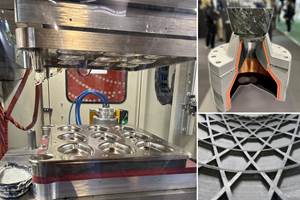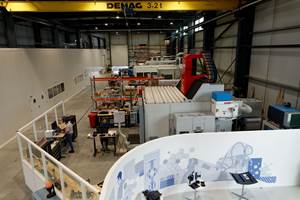Deepsea submersible incorporates composite pressure capsule
Spencer Composites Corp. (Sacramento, Calif.) fabricates the inner carbon/epoxy composite pressure capsule for a submersible deepsea vessel the late Steve Fossett was to take to the depths of the Pacific Ocean's Mariana Trench.
Prior to his untimely death in 2007, record-setting aviator and adventurer Steve Fossett — the first balloonist to fly nonstop around the world — was preparing to make a solo journey to the bottom of the Challenger Deep in the Pacific Ocean’s Mariana Trench, the deepest point in the undersea world. He aimed to exceed a 36,000 ft/19,500m dive made in 1960 in the same location by Jacques Piccard and U.S. Navy lieutenant Don Walsh in the bathyscaphe Trieste. His self-financed, one-person winged submersible vessel, the DeepFlight Challenger, was designed by Hawkes Ocean Technologies (HOT, San Francisco, Calif.).
HOT subcontractor Spencer Composites Corp. (Sacramento, Calif.) was given the task of designing and fabricating the DeepFlight Challenger’s inner carbon/epoxy composite pressure capsule. A filament-wound cylinder, the capsule has a thick glass viewing dome on one end and a titanium foot dome on the other. The domes would be attached to the composite laminate via bonded titanium rings. The tube wall thickness had to be sufficient to resist a biaxial stress field exerted by the deep ocean pressure of approximately 16,000 psi/1,100 bar, with a 1.5 factor of safety. According to Spencer Composites’ principal Brian Spencer, all other design factors, which included water ingress, temperature performance and ability to withstand handling loads in and out of the water, were insignificant compared to the external pressure load.
“A vessel for containing internal pressure, such as a hydrogen storage tank, puts carbon fiber in tension, which is the preferred loading state to achieve maximum composite performance. A pressure vessel for external pressure is more demanding because the composite strength in compression is much less than in tension.” Fiber volume, voids and delaminations become much more important, he adds, because these characteristics significantly impact the composite’s compressive strength and buckling resistance.
Using the finite element software code COSMOS/M orignially developed by Structural Research and Analysis Corp. (Santa Monica, Calif.) but now licensed by Dassault Systèmes SOLIDWORKS (Concord, Mass.), Spencer developed and optimized a laminate that uses only hoop and axial plies, in a ratio of about two hoops for every axial, using a repeated sequence that reduces strain variation through the laminate wall. “To reduce the strain variation and allow a higher overall applied load, we varied the hoop modulus through the wall thickness,” he explains. “The inner laminate has higher hoop stiffness than the outer laminate.” To ensure that the capsule would withstand full ocean pressure, the hoop compressive strain capability was targeted at 0.45 percent.
Spencer built a number of half-scale tubes to test several designs, including different hoop-to-axial fiber ratios, variations of fiber type and fibers of different moduli in the laminate. Tests were conducted at Pennsylvania State University’s (State College, Pa.) test laboratory, one of a handful in the U.S. able to generate the necessary compressive stress loads. Results were compared to the finite element model and anticipated failure modes. Spencer reports that the subscale samples withstood a maximum fiber compressive stress of more than 125 ksi/1,250 MPa and exhibited compressive strain capability that exceeded 0.48 percent.
The full-scale capsule was fabricated using a Spencer Composites-designed 4-axis CNC machine adapted for filament winding. The machine layed down a 2-inch/50-mm wide band of carbon fiber supplied by Grafil Inc. (Sacramento, Calif.). The toughened epoxy resin matrix was custom formulated by Spencer. The resulting oven-cured laminate, 5.15 inches/130 mm thick, has a fiber volume of 67 percent and “essentially zero voids,” claims the company. The finished capsule was delivered to HOT shortly before Fossett’s 2007 airplane accident.
The capsule is oriented at an angle within the 17.67 ft/5.4m long, 13 ft/4m wide, 5.5 ft/1.7m high submersible craft (see renderings above). The total weight is 4,730 lb/2,150 kg.
Currently owned by the Fossett estate, DeepFlight Challenger reportedly is capable of diving to deeper than 36,000 ft and returning to the surface in about five hours, claims HOT founder Graham Hawkes.
Mitsubishi Chemical Carbon Fiber & Composites Inc.
Related Content
JEC World 2024 highlights: Thermoplastic composites, CMC and novel processes
CW senior technical editor Ginger Gardiner discusses some of the developments and demonstrators shown at the industry’s largest composites exhibition and conference.
Read MoreWelding is not bonding
Discussion of the issues in our understanding of thermoplastic composite welded structures and certification of the latest materials and welding technologies for future airframes.
Read MorePlant tour: Daher Shap’in TechCenter and composites production plant, Saint-Aignan-de-Grandlieu, France
Co-located R&D and production advance OOA thermosets, thermoplastics, welding, recycling and digital technologies for faster processing and certification of lighter, more sustainable composites.
Read MoreDevelopment of a composite liquid hydrogen tank for commercial aircraft
Netherlands consortium advances cryogenic composites testing, tank designs and manufacturing including AFP, hybrid winding, welding of tank components and integrated SHM and H2 sensors for demonstrators in 2025.
Read MoreRead Next
Cutting 100 pounds, certification time for the X-59 nose cone
Swift Engineering used HyperX software to remove 100 pounds from 38-foot graphite/epoxy cored nose cone for X-59 supersonic aircraft.
Read MoreCeramic matrix composites: Faster, cheaper, higher temperature
New players proliferate, increasing CMC materials and manufacturing capacity, novel processes and automation to meet demand for higher part volumes and performance.
Read MoreScaling up, optimizing the flax fiber composite camper
Greenlander’s Sherpa RV cab, which is largely constructed from flax fiber/bio-epoxy sandwich panels, nears commercial production readiness and next-generation scale-up.
Read More












